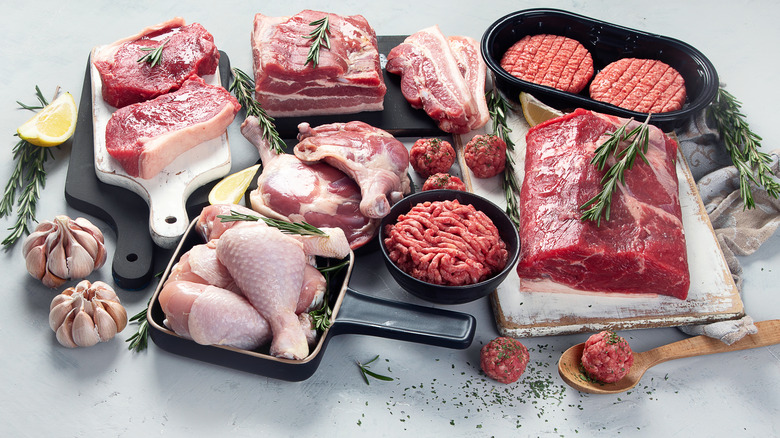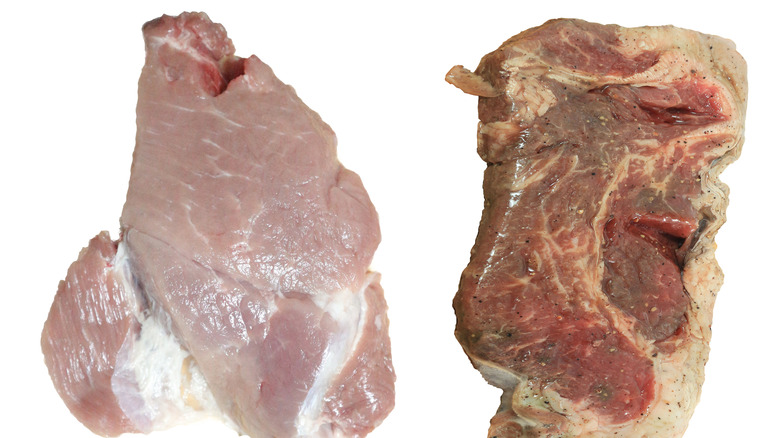Signs Your Meat Has Gone Bad
When the sun is shining bright, the warm weather calls for dinner parties and cookouts. As the sun rises, so does the sale of proteins, with steak sales alone going up 10% each grilling season, according to a 2021 report from Beef. It's What's For Dinner.
If you're in the mood for grilled or baked poultry items, it's good to know some tips and tricks to ensure you don't eat spoiled chicken, as Healthline explains. Any time you consume bad meat, you're putting your body at risk of food poisoning. Spoiled meat is full of bacteria, which can lead to vomiting, diarrhea, and even hospitalization — a far different trip than the cookout you may have had planned. And it's not just poultry you need to be careful with. According to Healthline, ground beef can also pose risks. With any fresh meat, you want to make sure that what you're cooking with won't pass on any foodborne illness to you and your dinner guests.
Fortunately, it's fairly easy to tell if what was once going to be your famous chicken bake casserole has turned into the latest ride on the trash chute express. You'll just need to rely on sight and smell — here's what to look for when inspecting that raw meat in your fridge.
Check the expiration date
It may sound simple, but the easiest way to see if raw meat has gone bad is to check the date on the meat's label from the grocery store. Fresh chicken, beef, or other meats stored in your fridge should be consumed by the printed expiration date at the latest.
Freezing fresh meat is a convenient way to extend its shelf life, though it may affect the meat's taste. With both chicken and beef, the USDA recommends either using fresh meat within one to two days of purchase or freezing it to use safely at a later date.
"At home, immediately place chicken in a refrigerator that maintains a temperature of 40 °F or below. Use it within 1 or 2 days, or freeze it at 0 °F," advises the USDA. "If kept frozen continuously, it will be safe indefinitely. The quality of the poultry may diminish the longer it is frozen."
Check the smell
While you shouldn't rely on the food sniff test alone, if the meat in your fridge is giving off a foul odor, it's safe to assume it's no longer good. Much like you see on crime TV, when you smell something rancid, you know it's gone bad, says Today. Because of this, smell has become the easiest way to know you're in the presence of spoiled meat.
Still, as the USDA notes, bacteria such as Salmonella and Escherichia coli can't be detected by smell. Even if your raw meat doesn't have a stench emanating from it, you should still check its texture and color.
If you take a quick whiff of your poultry and have to turn away swiftly, it's safe to say it shouldn't be consumed. (Still, as Livestrong points out, raw meat that smells like potent veggies such as garlic or onions isn't cause for concern if the meat was stored near these items in the fridge.)
Check the texture and color
If you've given that package of meat the sniff test and haven't smelled anything off, you can give it a quick look and see all you need to know. While bacteria can cause that well-known and dreadful smell, the tell-tale odor may not be present, meaning you have to use your eyes and touch to figure it out, per Today.
Spoon University explains that spoiled meat will change color. Beef should always be a brighter red color; pork, a grayish-pink; and chicken, a white-ish pink. If your meat doesn't match these colors, don't eat it. "Fresh-cut meat is purplish in color," the USDA says of beef. "The interior of the meat may be grayish brown due to lack of oxygen; however, if all the meat in the package has turned gray or brown, it may be beginning to spoil." As for chicken, toss it ASAP if it looks gray or green, Healthline advises.
As for the texture of the meat, does it feel slimy or sticky? If you answered "yes," throw it out. If the smell, texture, or color of your raw meat is off (or even worse, all three), head to your local grocer and get a replacement. You want your Sunday dinner to be memorable — just not for the wrong reasons.



